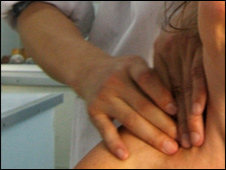 A new touch-sensitive nerve fibre responsible for the sense of pleasure experienced during stroking has been described at a UK conference today.
A new touch-sensitive nerve fibre responsible for the sense of pleasure experienced during stroking has been described at a UK conference today.
The nerves tap into a human’s reward pathways, and could help explain why we enjoy grooming and a good hug, a neuroscientist has explained.
His team used a stroking machine to reveal the optimal speed and pressure for the most enjoyable caress.
The research was presented at the British Association Science Festival.
Mothers stroke their children, monkeys groom group members, and we all enjoy a massage, but what is it about stroking and rubbing that we find so enjoyable?
“People groom because it feels good,” said Professor Francis McGlone, a cognitive neuroscientist at Unilever R&D, but went on to explain that little is known about how we experience the pleasure of touch.
In order to isolate the touch-sensitive nerves responsible for the pleasure experienced during stroking, Professor McGlone designed a “rotary tactile stimulator” – a high-tech stroking machine.
“We have built some very sophisticated equipment, so the stimulus [of stroking] is very repeatable.
“We stroke the skin [of the forearm, foreleg, and face] with a brush at different velocities, and then asked the volunteers to rate how they liked it,” he explained.
He also inserted microelectrodes through the skin, into a nerve, to record the neural signals running from the skin to the brain.
“It is like tapping a single phone-line and listening for the chatter that comes down that line,” he told the conference.
Feel-good chemicals
By comparing how the neural signals corresponded with how much the volunteers enjoyed the stroking, he was able to pin down people’s pleasure to one set of nerves called “C-fibres”.
He thinks that the stroking movements are activating C-fibres, which are wired into the rewards systems in the brain, causing the release of feel-good hormones.
Professor McGlone points out that these touch nerves are not responsible for the pleasure experienced from rubbing sexual organs, nor are they found in a person’s palms or soles.
“Experiencing pleasure when grappling with tools or walking, would make both task difficult to do with any accuracy,” he suggested.
The Liverpool-based researcher showed that stroking speeds of about 5cm per second, while applying 2g of pressure per square cm is optimal, and gave the volunteers most pleasure.
He explained that the pleasure messages are conveyed from the skin to the brain, by similar types of nerve fibres as those that transmit the sensation of pain.
“This is interesting as we often rub a pain to try to alleviate it,” he said.
This could explain why the pain experienced by people exposed to a painful thermal stimulus, lessens when the region of the stimulus is simultaneously stroked.
Stroking could be used to treat chronic pain, he suggests.
:: Read original here ::